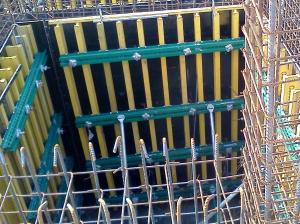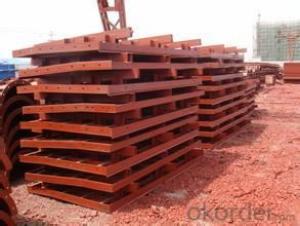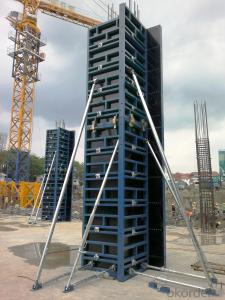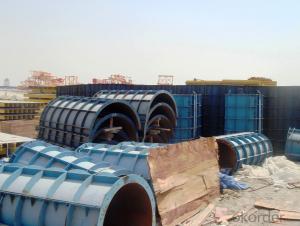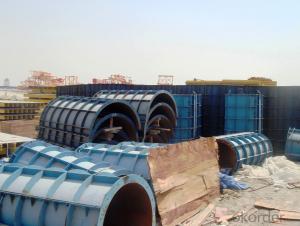Table Formwork system
- Loading Port:
- China Main Port
- Payment Terms:
- TT OR LC
- Min Order Qty:
- -
- Supply Capability:
- -
OKorder Service Pledge
Quality Product, Order Online Tracking, Timely Delivery
OKorder Financial Service
Credit Rating, Credit Services, Credit Purchasing
You Might Also Like
Tabel Formwork:
Table formwork is the most typical application for slab, with timber beam, the slab formwork is
light weight, fast and economic in the construction.
Characteristics:
◆ Simple structure, easy assembly.
◆ Flexible structure, be adapted to different support system.
◆ High construction efficiency with special system tools.
1. Lifting fork for lifting the table formwork to upper floor.
2. Trolley for moving the table formwork on floor.
◆ Flexible application with stand alone props.
◆ Safer condition with handrails.
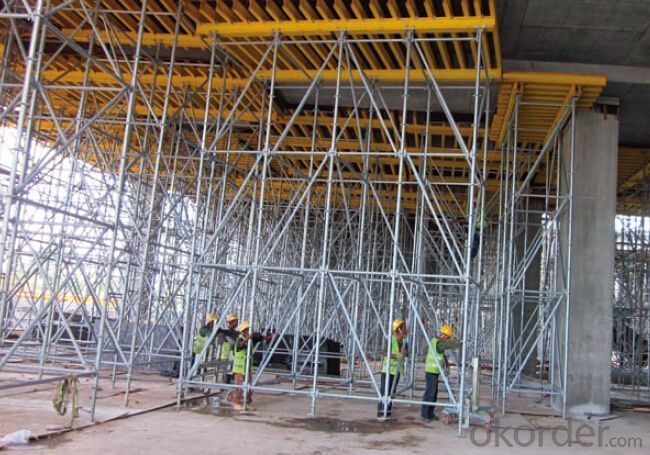
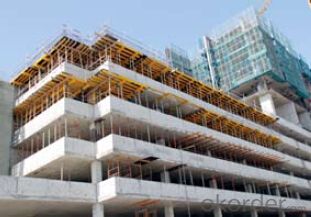
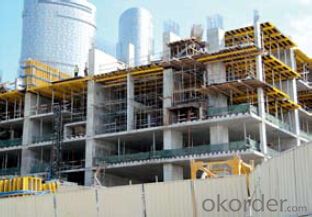
- Q:How does steel frame formwork contribute to the overall aesthetics of a structure?
- Steel frame formwork contributes to the overall aesthetics of a structure by providing a smooth and seamless finish. Its rigid and sturdy nature allows for precise and accurate concrete placement, resulting in clean lines and smooth surfaces. Additionally, steel formwork can be easily customized and adjusted to accommodate unique architectural designs, enhancing the visual appeal of the structure.
- Q:How does steel frame formwork contribute to better concrete curing?
- The utilization of steel frame formwork in construction involves the creation of molds using steel frames into which concrete is poured. This technique offers numerous benefits that enhance the curing of concrete. To begin with, the pouring of concrete with steel frame formwork ensures a high level of precision and stability. The steel frames are designed to be rigid and possess precise dimensions, guaranteeing that the formwork maintains its shape and does not deform during the curing process. This accuracy allows for even curing of the concrete, decreasing the likelihood of cracks or uneven surfaces. Furthermore, the utilization of steel frames allows for easy customization and flexibility in formwork design. The frames can be effortlessly adjusted and modified to accommodate various shapes and sizes of concrete structures. This adaptability ensures that the formwork aligns with the specific requirements of the project, resulting in improved concrete curing and a superior finished product. Moreover, steel frame formwork provides excellent support and reinforcement for the concrete during the curing process. The steel frames serve as a robust framework, preventing the concrete from sagging or bulging as it hardens. This support guarantees that the concrete maintains its desired shape and form, leading to a more durable and structurally sound final product. Additionally, steel frame formwork allows for efficient and convenient removal once the concrete has cured. The frames can be easily disassembled and reused for future projects, reducing waste and saving costs. This efficient removal process minimizes disruption to the curing concrete, ensuring that the curing process remains undisturbed and results in superior overall curing outcomes. In conclusion, the utilization of steel frame formwork significantly contributes to improved concrete curing through its precision, stability, support, and flexibility. By providing a high level of accuracy and strength, this construction technique ensures even curing of the concrete, resulting in a superior finished product. Additionally, the adaptability and efficient removal process offered by steel frame formwork further enhance the overall curing process and contribute to superior concrete outcomes.
- Q:How does steel frame formwork handle different types of formwork accessories?
- The versatility of steel frame formwork allows for easy accommodation of various formwork accessories. These accessories, such as form ties, wedges, formwork clamps, and scaffolding brackets, can be securely held in place by the steel frames. This ensures that they remain stable during the concrete pouring process, maintaining the integrity of the formwork system and achieving a high-quality finish. Attaching form ties to the steel frames is a simple process, as the frames have pre-drilled holes or slots specifically designed for this purpose. This facilitates quick and efficient assembly of the formwork system, saving time and labor during construction. Wedges play a crucial role in steel frame formwork, as they tighten and secure the form ties, preventing leaks or shifts in the formwork panels. The steel frames provide a secure grip for the wedges, allowing for easy adjustment and tightening as required. Formwork clamps are essential for holding the formwork panels in place, preventing movement or shifting. These clamps can be easily attached to the steel frames and offer a strong and stable connection. They are adjustable and suitable for different panel thicknesses, making them ideal for various construction projects. Scaffolding brackets are commonly used in conjunction with steel frame formwork to provide additional support and access for workers. These brackets can be easily attached to the steel frames, providing a safe and convenient platform for construction activities. They are designed to withstand heavy loads and offer stability during work. In conclusion, steel frame formwork is compatible with a range of formwork accessories. Its strong and rigid structure allows for secure attachment and efficient use of form ties, wedges, clamps, and scaffolding brackets. This versatility makes steel frame formwork a popular choice in the construction industry, as it can easily accommodate various types of formwork accessories.
- Q:How does steel frame formwork handle the placement of signage and wayfinding elements within the concrete structure?
- Steel frame formwork is an incredibly versatile and efficient system used for constructing concrete structures. It allows for the placement of signage and wayfinding elements within the structure. The steel frame provides a sturdy and reliable framework that easily accommodates the installation of these elements. When it comes to signage, steel frame formwork offers precise positioning and secure attachment of signs within the concrete structure. By incorporating designated areas or recesses into the formwork design, the signage seamlessly integrates into the concrete surface. This guarantees that the signs are securely fixed and will not be easily dislodged or damaged. Moreover, the steel frame formwork system offers flexibility in the design and placement of signage and wayfinding elements. The formwork can be customized to suit various sizes, shapes, and types of signage, allowing for visually appealing and informative structures. Whether it's large directional signs, small informational plaques, or even 3D elements, the steel frame formwork can be tailored to meet specific project requirements. Additionally, steel frame formwork enables efficient installation of signage and wayfinding elements. The formwork system is designed for easy assembly and disassembly, allowing for quick and accurate placement of signs during the construction process. This reduces installation time and costs, ensuring that the project stays on schedule. Overall, steel frame formwork offers a reliable and adaptable solution for incorporating signage and wayfinding elements into concrete structures. Its strength, flexibility, and ease of installation make it an ideal choice for securely and aesthetically integrating these elements into architectural designs.
- Q:What are the different types of formwork pins used in steel frame formwork systems?
- There are several different types of formwork pins that are commonly used in steel frame formwork systems. These pins are essential for securing the formwork panels and ensuring the stability of the entire structure. Some of the different types of formwork pins used in steel frame formwork systems include: 1. Wedge pins: These are the most commonly used formwork pins and are designed to secure the formwork panels together. They have a wedge shape that allows them to be easily inserted and removed. Wedge pins are typically made of steel and are available in various sizes to accommodate different thicknesses of formwork panels. 2. Flathead pins: These pins have a flat head and are used to hold the formwork panels in place. They are inserted through holes in the formwork panels and secured with a nut or washer on the opposite side. Flathead pins provide a secure connection and are often used in combination with other types of pins for added stability. 3. Connecting pins: These pins are used to connect two or more formwork panels together. They typically have a threaded end that allows them to be screwed into the panels. Connecting pins are commonly used in situations where a tight and secure connection is required, such as when forming corners or curved walls. 4. Tapered pins: These pins have a tapered shape, with one end being larger than the other. They are used to align and secure formwork panels by inserting the larger end into pre-drilled holes in the panels. Tapered pins provide a tight fit and are often used in conjunction with other types of pins for added stability. 5. Snap pins: These pins have a snap-on design that allows them to be easily attached and detached from the formwork panels. They are typically made of plastic or metal and are used in situations where frequent assembly and disassembly of the formwork is required. Overall, the different types of formwork pins used in steel frame formwork systems serve the purpose of securing the formwork panels and ensuring the stability of the entire structure. The specific type of pin used will depend on factors such as the formwork system being used, the thickness of the panels, and the desired level of stability and security.
- Q:What are the key considerations for selecting the appropriate steel frame formwork accessories?
- Several important factors need to be considered when choosing the appropriate steel frame formwork accessories. These factors include the compatibility of the accessories with the formwork system, their quality and durability, their ease of use and assembly, their load-bearing capacity, and their ability to provide a secure and stable support structure for the concrete. To begin with, it is crucial to ensure that the steel frame formwork accessories are compatible with the specific formwork system being utilized. Different formwork systems may have varying requirements in terms of dimensions, connections, and reinforcements. Therefore, it is essential to select accessories that are specifically designed to seamlessly integrate with the chosen system. Additionally, careful evaluation of the quality and durability of the accessories is necessary. The steel frame formwork accessories must be able to withstand the weight and pressure of the concrete, as well as external forces such as wind or vibrations. Opting for high-quality accessories made from robust materials will ensure that they can provide the necessary support and stability for the formwork system. Furthermore, ease of use and assembly is an important consideration. The accessories should be designed in a way that allows for easy assembly and disassembly, facilitating efficient and time-saving construction processes. Providing clear instructions and incorporating user-friendly features can greatly enhance the usability of the accessories. Moreover, the load-bearing capacity of the accessories should be taken into account. They must be able to safely support the weight of the concrete and any additional loads, such as workers or equipment, without any risk of failure or collapse. The determination of load-bearing capacity should be based on the specific requirements of the project and the expected loads that will be applied. Lastly, the accessories should provide a secure and stable support structure for the concrete. They should effectively maintain the desired shape and form of the concrete during the pouring and curing process, preventing any deformations or misalignments. In addition, they should be designed to minimize the risk of concrete leakage or seepage, ensuring that the desired surface finish and quality are achieved. In conclusion, the selection of steel frame formwork accessories requires careful consideration of their compatibility with the formwork system, their quality and durability, their ease of use and assembly, their load-bearing capacity, and their ability to provide a secure and stable support structure for the concrete. By thoroughly evaluating these key factors, one can guarantee the successful and efficient construction of concrete structures.
- Q:What are the different types of coatings or surface treatments applied to steel frame formwork?
- There are several different types of coatings or surface treatments that can be applied to steel frame formwork to enhance its performance and durability. 1. Galvanized Coating: Galvanization involves applying a layer of zinc to the steel surface through a process called hot-dip galvanizing. This coating provides excellent corrosion resistance, protecting the formwork from rust and other environmental damages. 2. Powder Coating: Powder coating is a popular method that involves applying a dry powder to the steel surface and then heating it to form a protective layer. This coating provides a durable finish, protecting the formwork from scratches, chemicals, and UV rays. 3. Epoxy Coating: Epoxy coatings are typically used in aggressive environments where corrosion resistance is crucial. These coatings are applied in multiple layers and provide excellent chemical resistance, protecting the formwork from acids, alkalis, and other corrosive substances. 4. Paint Coating: Paint coatings are a common choice for steel formwork. They provide a decorative finish while also offering some level of corrosion protection. However, paint coatings may require regular maintenance and may not be as durable as other types of coatings. 5. Zinc-Rich Primer: Zinc-rich primers are applied as a base coat before the final coating to provide additional corrosion protection. These primers contain high levels of zinc, which acts as a sacrificial anode and helps to prevent the steel from corroding. 6. Anodized Coating: Anodizing is a process mainly used for aluminum formwork, but it can also be applied to steel. It involves creating a layer of aluminum oxide on the surface through an electrochemical process. This coating provides enhanced corrosion resistance and can also improve the formwork's appearance. Overall, the choice of coating or surface treatment for steel frame formwork depends on the specific application, environmental conditions, and desired level of protection. It is essential to consider factors such as corrosion resistance, durability, aesthetics, and maintenance requirements when selecting the appropriate coating.
- Q:What are the different types of safety nets and fall protection systems used with steel frame formwork?
- To ensure worker safety, various safety nets and fall protection systems are commonly employed alongside steel frame formwork. These systems serve to prevent falls from heights and establish a secure working environment. Among the safety nets utilized with steel frame formwork, the perimeter safety net is prevalent. It encompasses the work area's perimeter, capturing any falling objects and preventing their descent to the ground or workers below. Typically crafted from robust materials like high-strength nylon or polypropylene, the perimeter safety net is engineered to withstand substantial impacts. Its presence is vital in averting accidents and injuries caused by falling debris. Another fall protection system employed with steel frame formwork is the safety harness and lanyard system. This system comprises a comprehensive body harness worn by workers, which connects to an anchorage point using a lanyard. By distributing the force of a fall across the worker's body, the harness reduces the risk of injury. Lanyards, usually composed of resilient materials such as nylon or polyester, are designed to absorb fall energy. In addition to safety nets and harness systems, guardrails find common usage in conjunction with steel frame formwork. These barriers encircle the work area's perimeter, preventing inadvertent worker falls. Constructed from durable materials like high-strength steel or aluminum, guardrails are engineered to withstand significant impacts. They serve as a physical barrier, continuously reminding workers of the potential hazards associated with working at heights. Lastly, safety platforms are frequently deployed alongside steel frame formwork to provide workers with stable and secure surfaces. Fabricated from steel or aluminum, these platforms are easily installed and removed. By offering a level area for workers to stand on while operating at heights, safety platforms reduce the risk of slips and falls. In conclusion, safety nets, harness systems, guardrails, and safety platforms constitute the various fall protection systems employed alongside steel frame formwork. These systems play a crucial role in averting falls from heights and ensuring workers' safety on construction sites.
- Q:How does steel frame formwork contribute to the overall cost of a construction project?
- Steel frame formwork can contribute to the overall cost of a construction project in several ways. Firstly, it may require a higher initial investment compared to other types of formwork, such as timber or aluminum. However, this cost is often justified by its durability and reusability, as steel formwork can withstand multiple uses without significant wear and tear. Additionally, steel formwork can help to expedite the construction process by allowing for faster assembly and disassembly, reducing labor costs. Moreover, its strength and stability can minimize the need for additional support structures, saving on material costs. Overall, while steel frame formwork may have a higher upfront cost, its efficiency and longevity can result in long-term cost savings for the construction project.
- Q:Can steel frame formwork be used for both horizontal and vertical formwork applications?
- Steel frame formwork is suitable for both horizontal and vertical formwork applications. It is a versatile and sturdy system that can be effortlessly assembled and modified to accommodate different shapes, sizes, and heights of concrete elements. Construction projects often utilize steel frame formwork for creating walls, columns, beams, slabs, and other structural elements. This formwork system offers exceptional stability and support, making it appropriate for both vertical and horizontal applications. Moreover, steel frame formwork boasts impressive load-bearing capacity, durability, and reusability, making it a cost-effective option for construction formwork.
1. Manufacturer Overview |
|
|---|---|
| Location | |
| Year Established | |
| Annual Output Value | |
| Main Markets | |
| Company Certifications | |
2. Manufacturer Certificates |
|
|---|---|
| a) Certification Name | |
| Range | |
| Reference | |
| Validity Period | |
3. Manufacturer Capability |
|
|---|---|
| a)Trade Capacity | |
| Nearest Port | |
| Export Percentage | |
| No.of Employees in Trade Department | |
| Language Spoken: | |
| b)Factory Information | |
| Factory Size: | |
| No. of Production Lines | |
| Contract Manufacturing | |
| Product Price Range | |
Send your message to us
Table Formwork system
- Loading Port:
- China Main Port
- Payment Terms:
- TT OR LC
- Min Order Qty:
- -
- Supply Capability:
- -
OKorder Service Pledge
Quality Product, Order Online Tracking, Timely Delivery
OKorder Financial Service
Credit Rating, Credit Services, Credit Purchasing
Similar products
New products
Hot products
Related keywords



















